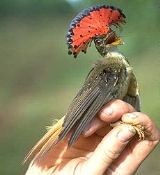
Northern Royal Flycatcher
Encyclopedia
The Northern Royal Flycatcher (Onychorhynchus mexicanus) is a species of bird
in the Tyrannidae family. It is, together with O. occidentalis and O. swainsoni, often considered a subspecies of O. coronatus.
It is found in Mexico
, south through most of Central America
, to north-western Colombia
and far western Venezuela
.
Its natural habitat
is subtropical or tropical moist lowland forest
s.
The Royal Flycatcher has an erectile fan-shaped crest, coloured red in the male and yellow-orange in the female. The display with the crest fully raised is seen extremely rarely, except during banding sessions.
The Northern Royal Flycatcher is usually inconspicuous and quiet, but sometimes gives a repeated sharp clear pree-o or key-up, sounding rather like a Manacus
manakin
or a jacamar
.
Bird
Birds are feathered, winged, bipedal, endothermic , egg-laying, vertebrate animals. Around 10,000 living species and 188 families makes them the most speciose class of tetrapod vertebrates. They inhabit ecosystems across the globe, from the Arctic to the Antarctic. Extant birds range in size from...
in the Tyrannidae family. It is, together with O. occidentalis and O. swainsoni, often considered a subspecies of O. coronatus.
It is found in Mexico
Mexico
The United Mexican States , commonly known as Mexico , is a federal constitutional republic in North America. It is bordered on the north by the United States; on the south and west by the Pacific Ocean; on the southeast by Guatemala, Belize, and the Caribbean Sea; and on the east by the Gulf of...
, south through most of Central America
Central America
Central America is the central geographic region of the Americas. It is the southernmost, isthmian portion of the North American continent, which connects with South America on the southeast. When considered part of the unified continental model, it is considered a subcontinent...
, to north-western Colombia
Colombia
Colombia, officially the Republic of Colombia , is a unitary constitutional republic comprising thirty-two departments. The country is located in northwestern South America, bordered to the east by Venezuela and Brazil; to the south by Ecuador and Peru; to the north by the Caribbean Sea; to the...
and far western Venezuela
Venezuela
Venezuela , officially called the Bolivarian Republic of Venezuela , is a tropical country on the northern coast of South America. It borders Colombia to the west, Guyana to the east, and Brazil to the south...
.
Its natural habitat
Habitat
* Habitat , a place where a species lives and grows*Human habitat, a place where humans live, work or play** Space habitat, a space station intended as a permanent settlement...
is subtropical or tropical moist lowland forest
Forest
A forest, also referred to as a wood or the woods, is an area with a high density of trees. As with cities, depending where you are in the world, what is considered a forest may vary significantly in size and have various classification according to how and what of the forest is composed...
s.
Description
The Northern Royal Flycatcher is 16.5–18 cm (6½-7") long, brown above small buffy spots on its wing-coverts; the rump and tail are tawny-ochraceous in colour. The bill is long and broad.The Royal Flycatcher has an erectile fan-shaped crest, coloured red in the male and yellow-orange in the female. The display with the crest fully raised is seen extremely rarely, except during banding sessions.
The Northern Royal Flycatcher is usually inconspicuous and quiet, but sometimes gives a repeated sharp clear pree-o or key-up, sounding rather like a Manacus
Manacus
Manacus is a genus of passerine birds in the manakin family which are found in the forests of tropical mainland Central and South America, and on Trinidad and Tobago...
manakin
Manakin
The manakins are a family, Pipridae, of unique small suboscine passerine birds. The family contains some 60 species. They are distributed through the American tropics...
or a jacamar
Jacamar
The jacamars are a family, Galbulidae, of near passerine birds from tropical South and Central America, extending up to Mexico. The order contains five genera and 18 species...
.

